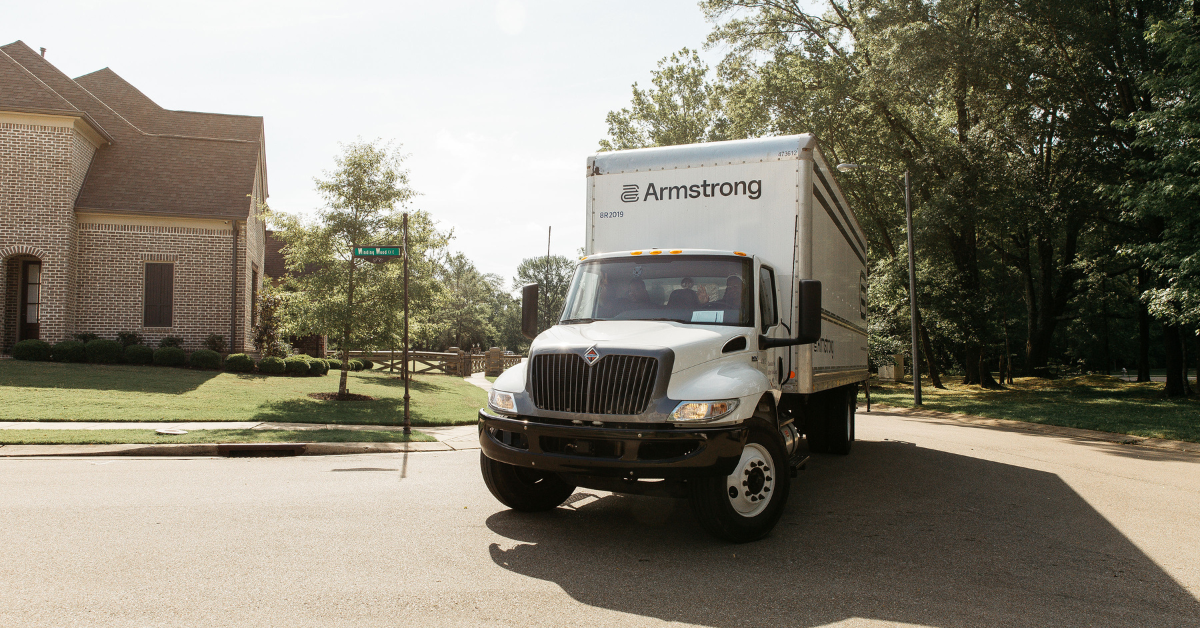Armstrong’s Comprehensive Guide for Residential Moving Services – Long Distance Moving

Long-distance moves involve more than just packing and transportation. From secure storage solutions to professional packing and vehicle transport, various services are designed to streamline the moving experience.
This guide explains the key long-distance moving services and how they contribute to a seamless relocation. Whether you’re moving across state lines or to a new region, this resource will help you understand the logistics and planning involved in a successful move.
Get a personalized moving estimate for your long-distance relocation—request a free quote today!
I. Long-Distance Moving + Employee Relocation Services
1. Full-Service Long-Distance Moving
A full-service long-distance move covers every stage of relocation, making it a practical option for those moving to another state or across the country. This type of move includes professional packing, secure transportation and assistance with unpacking and setup, helping to manage the complexities of a long-distance relocation.
Here’s what a full-service long-distance move typically includes:
- Move Coordination: A dedicated move coordinator manages logistics, schedules and communication throughout the relocation process.
- Packing Services: Movers pack items using protective materials designed for long-distance travel to prevent damage in transit.
- Loading and Transportation: Belongings are securely loaded onto moving trucks, transported across states or regions and tracked along the way.
- Unloading and Unpacking: Upon arrival, movers unload items and can assist with unpacking and furniture placement.
- Debris Removal: After unpacking, packing materials and debris are collected and disposed of, keeping the new home organized.
Benefits of Full-Service Long-Distance Moving
A full-service long-distance move allows you to focus on your transition while professionals manage the entire moving process, ensuring every detail is handled efficiently. With expert packing, secure transportation and comprehensive logistics management, this service ensures your move is efficient and stress-free. Whether you’re changing cities for a new job, relocating to be closer to family or starting fresh in a new state, full-service moving helps you settle into your new home with ease.
Learn more about the advantages of full-service moving and how it can simplify your long distance relocation today!
2. Partial-Service Long-Distance Moving
Partial-service long-distance moving allows you to select specific services while managing the rest of the move on your own. This option is ideal for those who need help with tasks like packing, loading or transportation but prefer to handle other aspects independently.
Here’s how a partial-service long-distance move can be customized:
- Packing Assistance: Movers can pack fragile or high-value items, such as glassware, electronics or artwork, while you handle the rest.
- Loading and Unloading: Heavy furniture and large belongings can be professionally loaded and unloaded, reducing physical strain and ensuring safe handling.
- Transportation: Whether you pack your belongings yourself or with assistance, professional movers handle the long-distance transport to ensure safe and timely delivery.
- Custom Crating: For delicate or valuable items, custom crating provides additional protection during extended travel.
Benefits of Partial-Service Long-Distance Moving
Partial-service long-distance moving provides flexibility by allowing you to choose only the services you need. This can help manage costs while ensuring professional support for the most physically demanding or complex parts of the move.
Because long-distance moves involve extended travel and multiple handling points, belongings are at a higher risk of shifting or damage. Selecting professional packing, crating or loading services can provide additional protection, especially for fragile or valuable items.
Customizing Your Long-Distance Move
When planning a long-distance move, it’s important to assess your specific needs based on distance, time constraints and the complexity of the relocation. An interstate move often requires extra protection for belongings, careful scheduling and strategic packing to withstand extended travel. Consider which tasks require professional assistance, such as securing fragile items, loading heavy furniture or ensuring safe transportation over long distances. Selecting services that address these challenges can help streamline the process and provide peace of mind, ensuring your belongings arrive safely and on time.
Choose the long-distance moving services that best fit your needs and create a customized plan for a smooth, stress-free relocation.
3. Packing & Unpacking Services
Packing for a long-distance move requires extra care to ensure belongings remain secure during extended transportation. Professional packing and unpacking services help protect items from damage, making the moving process more efficient and less stressful. These services are ideal for those managing other aspects of their long-distance relocation but want assistance with properly packing, organizing and unpacking their belongings.
Here’s what our packing and unpacking services include:
- Professional Packing: Movers provide all necessary packing materials and carefully wrap and secure items, paying special attention to fragile and high-value belongings.
- Inventory and Labeling: A detailed inventory is created, and all boxes are labeled clearly for easy identification upon arrival at the new home.
- Unpacking and Reassembly: Once at the destination, movers unpack boxes and reassemble furniture that was taken apart for transport.
- Debris Removal: All packing materials and debris are collected and disposed of, ensuring a clean and organized space after the move.
Partial Packing & Unpacking
If full-service packing isn’t needed, partial packing and unpacking allow flexibility. This option is helpful for those who want assistance with a few items while handling the rest on their own. Professional packing is recommended for:
- Fragile Items: Glassware, artwork, mirrors and other breakables that require extra padding for long-distance travel.
- Valuable Items: Electronics, antiques and collectibles that need special handling to prevent damage in transit.
- Bulky or Complex Items: Large furniture, irregularly shaped items or anything that is difficult to pack securely for an extended journey.
Because long-distance moves involve extended travel, ensuring that belongings are packed correctly is crucial for their safety. Choosing professional packing for delicate or high-value items can help prevent damage, giving peace of mind during the relocation.
Learn expert tips on how to pack your house quickly and efficiently for a long-distance move.
4. Specialty Services
Crating & Specialty Item Packing
Protecting fragile, valuable or irregularly shaped items is especially important during a long-distance move, where extended transportation increases the risk of damage. Crating offers a secure solution by using custom-built wooden containers designed to prevent shifting, vibrations and excessive handling throughout the journey.
When crating is recommended for long-distance moves:
- Fine Art: Paintings, sculptures and other delicate artwork are secured in custom crates to withstand prolonged transit and multiple handling points.
- Antiques: Fragile antique furniture and valuable collectibles are carefully packed in reinforced crates to preserve their condition during a cross-country or interstate move.
- Electronics: Large televisions, high-end audio equipment and other sensitive electronics are crated to prevent damage from movement, impact or shifting in transit.
For a cross-country move, crating is the best way to protect important belongings that you don’t want to risk damaging. It provides the extra security needed to keep fragile and valuable items safe throughout long-distance transport.
Item Disassembly & Reassembly
Certain household items, such as large furniture and exercise equipment, may need to be taken apart before a long-distance move to prevent damage and ensure safe transport. Disassembling these items makes them easier to handle and reduces the risk of breakage during extended travel. Professional disassembly and reassembly services help simplify this process, ensuring that everything is properly reassembled and ready to use in your new home.
Common items that may require disassembly for long-distance moving:
- Furniture: Beds, dining tables and large wardrobes are often taken apart to prevent damage and allow for more efficient packing.
- Exercise Equipment: Treadmills, ellipticals and other workout machines may need disassembly to fit securely in the moving truck and ensure safe transport.
- Specialty Items: Items with complex components, such as home office setups or entertainment centers, can be disassembled and reassembled for a smoother transition.
Discover the best practices for safely moving high-value items during a long-distance relocation!
5. Storage Solutions
Short-Term Storage
During a long-distance move, there may be times when you need a secure place to store your belongings temporarily. Short-term storage provides a flexible solution for various situations, such as:
- Coordinating Move-In Dates: If your new home isn’t ready when you arrive, storage helps bridge the gap between moving out and settling in.
- Downsizing Before a Move: If you’re relocating to a smaller home, temporary storage allows you to sort through belongings at your own pace.
- Job Relocations: If you’re moving for work but haven’t secured permanent housing yet, storing your items short-term keeps them safe until you do.
- Delays in Transportation: Cross-country moves can sometimes experience delays. Storage ensures your belongings are kept secure until they can be delivered.
When choosing a short-term storage facility for a long-distance move, security is essential. Look for features like 24/7 surveillance, restricted access and secure entry systems to keep your belongings safe.
For added protection, temperature-controlled storage can help prevent damage to temperature-sensitive items such as electronics, furniture, artwork and important documents. This ensures that your belongings remain in good condition while in temporary storage before reaching your new home.
Long-Term Storage
Unlike short-term storage, which is used for brief periods during a move, long-term storage is ideal for keeping belongings safe for an extended time when they won’t be immediately needed in your new home. This can be especially useful for those transitioning between living spaces or planning for future use of certain items. Whether you’re moving cross country or to another state, long-term storage provides a secure and reliable option for storing possessions until you’re ready for them.
Common reasons for using long-term storage during a long-distance move include:
- Delays in Permanent Housing: If you’re moving but don’t have a permanent home yet, long-term storage keeps your belongings secure until you’re ready to settle in.
- Downsizing: Moving into a smaller home or apartment may mean you don’t have space for all your belongings right away, but storage allows you to keep them for future use.
- Extended Travel or Assignments: For those relocating temporarily for work, military deployment or an extended stay abroad, long-term storage ensures personal items remain safe.
- Preserving Sentimental or Seasonal Items: Items like family heirlooms, holiday decorations or off-season furniture can be kept in storage until they are needed.
Long-term storage offers flexible options, allowing belongings to be stored for months or even years. When choosing a facility, it’s important to consider security measures, climate control for temperature-sensitive items and insurance coverage to ensure your possessions remain protected throughout the storage period.
Need extra time before move-in? Discover how storage in transit can keep your items protected.
6. Decluttering & Organization Services
Decluttering and organization services help streamline the moving process by assisting with sorting, organizing and deciding what to keep, donate or discard before a long-distance move. Professional organizers create a structured plan to make downsizing more manageable, ensuring that only essential and meaningful items make the journey to your new home. Some services even offer eco-friendly disposal solutions, helping to responsibly donate or recycle unwanted belongings instead of sending them to landfills.
Since long-distance moving requires careful planning and logistics, reducing the number of items you bring can have several benefits:
- Lower Moving Costs: Fewer items mean lower transportation fees and reduced packing supply expenses for cross-country or interstate moves.
- Simplified Packing & Unpacking: A more organized move makes packing easier and speeds up the unpacking process in your new home.
- Avoiding Unnecessary Items: A long-distance relocation is an opportunity for a fresh start—bringing only what you truly need helps create a clutter-free living space.
Sorting through years of accumulated belongings can feel overwhelming, but with the right support, the process becomes more efficient and stress-free, ensuring a smoother long-distance moving experience.
Find out how to sort, simplify, and declutter your belongings before your big move!
7. Transportation
With extended travel distances and multiple handling points, it’s important to choose a moving company that prioritizes driver expertise, vehicle maintenance and safety measures to ensure secure transportation. Here’s what to look for:
Driver Qualifications for Long-Distance Moves
Look for professional long-distance movers who prioritize experience and actively participate in ongoing training programs. These programs should cover highway safety, defensive driving and compliance with interstate transportation regulations. Professionalism and a commitment to customer service are also essential, as long-distance drivers must communicate effectively, provide updates on delivery timelines and navigate cross-country routes efficiently.
Safety and Tracking Measures
- Vehicle Maintenance: Well-maintained trucks reduce the risk of breakdowns and delays during long-distance travel.
- Secure Loading and Transport: Professional loading techniques, padding and tie-downs help prevent items from shifting in transit.
Reliable Fleet for Long-Distance Moves
The right type of moving truck is essential for safely transporting belongings over long distances. Moving companies often have a fleet of vehicles designed for different move sizes, including:
- Large Moving Trucks: Equipped to handle full-household relocations with multiple rooms and bulky furniture.
- Specialized Vehicles: Designed for transporting high-value or fragile items that require additional protection.
Every long-distance move is unique, which is why selecting the right vehicle is crucial for a safe and efficient relocation. For cross-country and interstate moves, our team evaluates several factors, including the distance, volume of belongings and transportation requirements, to ensure the truck can securely accommodate the size and weight of your household items throughout the journey.
Explore the day-to-day responsibilities of a van operator and their role in a successful move.
II. Why Choose Armstrong
The Armstrong Company has been a trusted name in long-distance moving for over six decades. With locations in multiple cities across the country, we have the resources and nationwide network to make cross-country and interstate moves more efficient. Our extensive reach allows us to coordinate logistics seamlessly, ensuring that every stage of your move is handled with precision and care.
Over the years, we’ve refined our process to provide a smooth and reliable moving experience. Our professional teams are experts in long-distance transportation, navigating complex routes, managing timelines and ensuring that your belongings, whether delicate antiques or bulky furniture, arrive safely at your new home.
In recognition of our commitment to excellence, Armstrong was honored as United Van Lines’ 2024 Top Hauler for Household Goods. This prestigious award underscores our dedication to providing superior service and ensuring that every move, no matter the distance, is handled with the utmost care and precision.
Avoid moving mistakes! Check out the 12 essential considerations before hiring cross-country movers.
III. Moving Tips and Resources
Additional Resources for Long-Distance Moving
Planning a long-distance move involves more logistics and preparation than a local relocation. Staying organized and informed can help make the process smoother and reduce stress. Here are some helpful resources to guide you:
- Checklist for a Long-Distance Move: A detailed moving checklist can help you stay on top of important tasks, from sorting and packing your belongings to scheduling transportation and setting up services in your new home. Using a structured timeline ensures nothing is overlooked during the process.
- Practical Moving Tips: Armstrong offers a variety of resources to help with long-distance moving, including guides on how to select a reputable moving company, practical packing strategies and ways to make the transition easier. These insights can help you navigate the challenges of a cross-country move with confidence.
IV. FAQs
What qualifies as a long-distance move?
A long-distance move is typically defined as any relocation that crosses state lines or covers a significant distance, usually over 100 to 400 miles. Unlike local moves, which are generally within the same city or region, long-distance moves involve more complex logistics, such as interstate regulations, higher transportation costs and extended travel times.
How far in advance should I start planning a long-distance move?
It’s best to start planning a long-distance move at least 8 to 12 weeks in advance to allow time for researching movers, obtaining quotes, sorting and packing belongings and making necessary travel arrangements. Booking a moving company early is especially important during peak moving seasons, such as summer, when availability can be limited.
How is the cost of a long-distance move calculated?
The cost of a long-distance move is typically based on factors such as the distance traveled, the total weight of belongings, the number of services requested (e.g., packing, storage or specialty handling), and the time of year. Additional factors like fuel prices, insurance coverage and whether the move requires multiple shipments or storage may also affect the overall cost.
How long does a long-distance move usually take?
A long-distance move can take anywhere from several days to a few weeks, depending on the distance, route, weather conditions and the moving company’s scheduling. Unlike local moves, where delivery is often completed on the same day, long-distance moves involve multiple stops, cross-country transportation and specific delivery windows that may vary based on logistics.
What items cannot be transported in a long-distance move?
Certain items are restricted or prohibited in long-distance moves for safety and legal reasons. These typically include hazardous materials such as flammable liquids, propane tanks, fireworks and corrosive chemicals. Perishable items like food, plants and certain live animals are also not allowed due to transportation regulations. Additionally, valuables such as important documents, jewelry and high-value electronics are often recommended to be transported personally rather than packed with household goods.
V. Contact Us
Planning a long-distance move comes with many details to consider, and Armstrong is here to help every step of the way. Whether you need guidance on packing, transportation or storage solutions, our team is available to answer your questions and provide expert recommendations tailored to your move.
📞 Phone number: 800.288.7396
📧 Email address: [email protected]
For a quick estimate on your long-distance move, use our online ballpark estimate tool to get an instant idea of costs. It’s simple, fast and helps you start planning with confidence. Get your estimate now!
Conclusion
Successfully relocating to a new state or across the country involves many moving parts, from packing and transportation to logistics and timing. Whether you need full-service assistance for every aspect of your move or just help with specific tasks like packing, transportation or storage, there are solutions to fit your needs. Choosing the right combination of services can streamline the process, reduce stress and ensure your belongings arrive safely at your new home, no matter the distance.
With the right preparation and expert support, navigating a long-distance move can be a seamless experience. Ready to take the next step? Schedule a virtual survey with Armstrong today and start planning your move with confidence.


